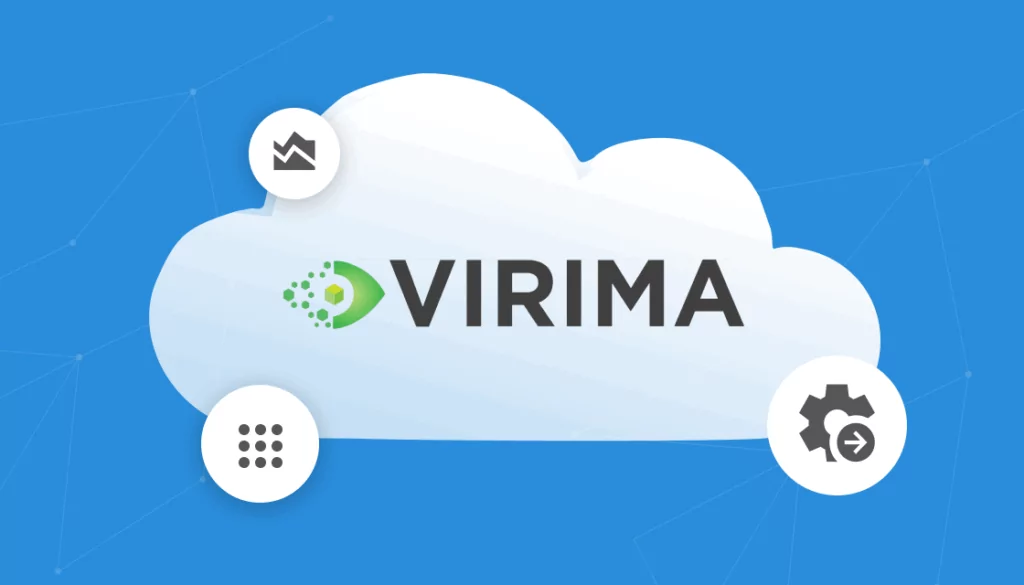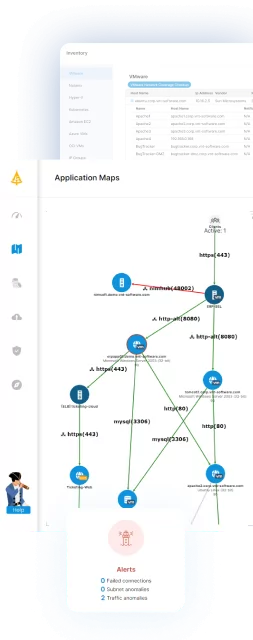What Are Application Dependency Mapping Platforms?
Application dependency mapping (ADM) platforms automatically identify and visualize the relationships between applications, services, and infrastructure components. These tools help organizations understand how applications interact, detect dependencies, and track changes in real time.
ADM platforms are crucial for IT operations, cloud migrations, security audits, and incident response. They provide insights into system architecture, helping teams optimize performance, troubleshoot issues, and ensure compliance. By continuously monitoring dependencies, ADM platforms reduce risks associated with configuration changes and service disruptions.
Table of Contents
ToggleKey Features of ADM Platforms
Application dependency mapping platforms typically include the following capabilities.
Automated Discovery
ADM platforms use various methods—agent-based, agentless, or hybrid—to scan IT environments and detect application dependencies. Agent-based discovery involves installing lightweight software on servers to gather real-time data, while agentless discovery connects through APIs, network protocols, or log analysis to identify relationships without installing software.
These tools detect infrastructure components such as servers, databases, virtual machines, microservices, and cloud instances. They map how these components interact, helping organizations understand their architecture without relying on manual documentation. This reduces errors, accelerates IT audits, and improves visibility into shadow IT—unauthorized systems that could pose security risks.
Real-Time Visualization
ADM platforms generate interactive maps that dynamically update as changes occur. These visualizations illustrate dependencies across applications, databases, and services, helping teams understand the impact of failures or modifications.
Real-time visualization enables IT teams to:
- Quickly diagnose incidents by identifying affected services and their dependencies.
- Detect redundant or underutilized resources, optimizing costs and performance.
- Improve cloud migration planning by mapping application architectures before, during, and after the transition.
Change Tracking
ADM platforms continuously monitor applications and infrastructure for changes, logging modifications in real time. Every update—whether a software deployment, configuration change, or new service connection—is recorded to provide historical context for troubleshooting and compliance audits.
With change tracking, organizations can:
- Identify unauthorized modifications that may lead to security vulnerabilities.
- Analyze performance trends by correlating changes with system behavior.
- Prevent outages by detecting risky changes before they cause failures.
Some platforms offer automated alerts for critical changes, ensuring that IT teams can respond quickly to unintended modifications. Integration with IT service management (ITSM) tools further improves visibility into the change management process.
Performance Monitoring
ADM platforms improve IT performance by identifying dependencies that contribute to slow response times, network congestion, or resource contention. By continuously monitoring application interactions, these tools help detect performance bottlenecks before they impact end users.
Key performance monitoring capabilities include:
- Latency analysis to identify slow inter-service communications.
- Resource utilization tracking for optimizing CPU, memory, and storage usage.
- Dependency-based alerting that notifies teams when performance thresholds are exceeded.
Security and Compliance
ADM platforms strengthen security by identifying unauthorized or vulnerable dependencies. They detect misconfigurations, unencrypted connections, and unapproved third-party integrations that could expose an organization to risks.
For compliance, these platforms:
- Ensure data flow transparency, helping organizations meet regulations like GDPR, HIPAA, and PCI DSS.
- Monitor access permissions, detecting unauthorized changes that could lead to data breaches.
- Support forensic investigations by providing detailed dependency change logs.
Use Cases of ADM Platforms
Incident Management and Troubleshooting
ADM platforms simplify incident response by providing real-time visibility into application dependencies. When an issue arises, IT teams can quickly identify which services, databases, or infrastructure components are affected. This reduces mean time to resolution (MTTR) by enabling faster root cause analysis.
Key benefits include:
- Dependency-aware alerting, helping teams prioritize critical issues.
- Impact analysis, showing how failures propagate across the system.
- Historical change tracking, allowing teams to pinpoint configuration changes that led to incidents.
Cloud Migration and Optimization
ADM platforms help organizations map existing application dependencies before migrating workloads to the cloud. This prevents common migration issues such as broken service links, misconfigured networking, and unexpected latency.
Use cases include:
- Pre-migration assessment, identifying applications that rely on on-premises infrastructure.
- Migration validation, ensuring dependencies remain intact post-migration.
- Cost and performance optimization, detecting underutilized resources for rightsizing.
By providing a clear blueprint of application interactions, ADM platforms enable smoother cloud transitions and ongoing performance improvements in multi-cloud or hybrid environments.
DevOps and CI/CD Pipelines
ADM platforms support DevOps teams by improving visibility into service dependencies within continuous integration and deployment (CI/CD) workflows. They help prevent deployment failures caused by overlooked dependencies or misconfigured integrations.
Key advantages include:
- Automated dependency validation before code deployments.
- Rollback support, allowing teams to revert changes if performance degrades.
- Microservices monitoring, ensuring seamless interactions between containerized applications.
Security Auditing and Risk Assessment
ADM platforms strengthen security by identifying unprotected dependencies, unauthorized services, and potential attack paths. They provide real-time monitoring of security-related changes, helping organizations enforce policies and comply with regulations.
Security-related benefits include:
- Unauthorized service detection, identifying shadow IT or unapproved third-party integrations.
- Access control verification, ensuring that only authorized systems communicate.
- Regulatory compliance support, with automated audits for frameworks like GDPR, HIPAA, and NIST.
5 Leading Application Dependency Mapping Platforms
1. Faddom
Faddom is a lightweight, agentless application dependency mapping platform that provides organizations with real-time visibility into their hybrid IT environments. It features continuous discovery, change tracking, and dynamic visualization of infrastructure and application relationships. All without requiring credentials or active network scanning.
Key features include:
- Agentless passive discovery: Deploys in under 60 minutes without requiring agents or credentials. Monitors north-south and east-west traffic across on-premises and cloud environments using a passive method that does not impact performance.
- Live visualization: Provides real-time, interactive maps of application dependencies, services, ports, and protocols, helping teams visualize their complete IT architecture.
- Change tracking: Continuously logs infrastructure and application-level changes for IT governance, compliance, and troubleshooting.
- Use case versatility: Supports a wide range of IT needs including cloud migration planning, IT documentation, change impact analysis, security audits, and optimization.
- Network security: Identifies shadow IT, unauthorized connections, and unencrypted or non-compliant traffic. Helps enforce segmentation policies and reduce exposure to risks.
- Integrations: Easily integrates with ITSM and SIEM tools like ServiceNow and Splunk, enhancing existing workflows.
2. ServiceNow ITOM
ServiceNow IT Operations Management (ITOM) provides visibility into IT environments across on-premises and cloud infrastructures. It helps organizations map application dependencies, predict issues, and automate resolutions using generative AI.
Key features include:
- Discovery: Automatically identifies and maps IT components, including servers, databases, and cloud services.
- Service mapping: Visualizes relationships between IT infrastructure and business services, improving the accuracy of dependency tracking.
- Predictive AIOps: Uses AI-driven analytics to detect anomalies, predict failures, and optimize issue resolution.
- Configuration management database (CMDB): Offers a centralized repository for tracking IT assets, configurations, and dependencies.
- Firewall audits and reporting: Monitors firewall policies, helping ensure compliance and security.
Source: ServiceNow
3. BMC Helix Discovery
BMC Helix Discovery provides agentless, continuous discovery of IT assets and their dependencies across cloud and on-premises environments. It aims to help organizations gain visibility, improve security, and improve operational efficiency. By integrating with the BMC Helix platform, it enables observability and AIOps-driven insights.
Key features include:
- Agentless continuous discovery: Automatically detects and maps IT assets and service dependencies without requiring manual updates.
- Blueprint-automated service modeling: Uses predefined service modeling templates to visualize infrastructure supporting business needs.
- Data reconciliation: Merges topology data from multiple sources to provide a unified view of IT environments.
- Real-time service awareness: Links service models, topology, and telemetry to identify root causes and assess impact.
- Security and compliance monitoring: Identifies risks, helps detect hidden assets, and ensures regulatory compliance with automated asset inventories.
Source: BMC
4. Dynatrace Topology Discovery and Application Mapping
Dynatrace Topology Discovery and Application Mapping provides AI-based discovery of IT components and their dependencies across a technology stack. With automatic mapping and continuous learning, it delivers insights into application architecture, helping organizations optimize performance, detect anomalies, and simplify IT operations.
Key features include:
- Auto-discovery: Maps all components and dependencies across applications, services, hosts, networks, and infrastructure with one agent.
- Smartscape technology: Provides an interactive visualization of application topology and relationships.
- Technology coverage: Supports AWS, Azure, Kubernetes, Docker, MySQL, .NET, and other platforms.
- Self-learning AI: Automatically detects performance anomalies, reducing the need for manual threshold adjustments.
- Automated root-cause analysis: Uses AI and big data analytics to pinpoint the source of performance issues.
Source: Dynatrace
5. AWS Application Discovery Service
AWS Application Discovery Service helps organizations plan cloud migrations by automatically collecting configuration and usage data from on-premises servers and databases. It integrates with AWS Migration Hub and AWS Database Migration Service (DMS) Fleet Advisor to simplify migration tracking and decision-making.
Key features include:
- Agentless discovery: Uses VMware vCenter integration to collect system performance data from virtual machines without installing agents.
- Agent-based discovery: Provides insights into server performance, network connections, and running processes by installing an agent on each machine.
- File-based import: Allows users to import on-premises server details into AWS Migration Hub for assessment and planning.
- Application and network dependency mapping: Identifies server relationships and dependencies to support smooth migration.
- Database discovery: Captures metadata and performance metrics from database and analytics servers using LDAP and Active Directory.
Source: Amazon
Related content: Read our guide to IT mapping
Conclusion
ADM platforms provide critical insights into application dependencies, enabling organizations to improve performance, enhance security, and simplify IT operations. By automating discovery, visualization, and monitoring, they help organizations improve performance, strengthen security, and reduce operational risks. Whether for incident response, cloud migration, or compliance audits, ADM platforms aid in reducing risks and ensuring system reliability.
The right tool can provide real-time visibility, streamline cloud migrations, reduce security risks, and support faster incident response. While all five platforms bring strong capabilities, some offer faster deployment, more flexible discovery methods, and greater cost transparency, making them especially appealing for teams seeking quick time-to-value and minimal setup. As organizations prioritize agility and efficiency, lightweight, agentless solutions are emerging as the preferred approach for modern application dependency mapping.






